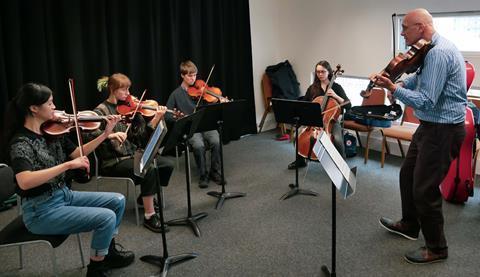- News
- For Subscribers
- Student Hub
- Playing Hub
- Directory
- Lutherie
- Magazine
- Magazine archive
- Whether you're a player, maker, teacher or enthusiast, you'll find ideas and inspiration from leading artists, teachers and luthiers in our archive which features every issue published since January 2010 - available exclusively to subscribers. View the archive.
- Jobs
- Shop
- Podcast
- Contact us
- Subscribe
- School Subscription
- Competitions
- Reviews
- Debate
- Artists
- Accessories
Teaching chamber music: light-bulb moments

Giving formal chamber music training to students during their school years is vital for fostering a lifelong commitment to the art, writes Graham Oppenheimer, senior chamber music tutor at Chetham’s School of Music in Manchester

I can still vividly recall my first experience of chamber music as a twelve-year-old at summer school. I was amazed not only by the ingenious construction of the finale of Mozart’s String Quartet in G major K387 but also by the freedom and brilliance of my own voice. I realised that my part mattered in this wonderful new medium. This was a real light-bulb moment that has always remained with me. Since then I have felt privileged to have had a career dedicated to chamber music, and as senior chamber music tutor at Chetham’s School of Music in Manchester since 2002, I have been able to create such opportunities for others. My fellow teachers and I feel passionately about the importance of chamber music for young string players and recognise that one of our very important tasks is to oversee similar light-bulb moments for our own students.
Chetham’s is a specialist music school for students aged 8 to 18, many of whom arrive having never played chamber music before. We introduce them to experiences that can be among the most dynamic and exciting available to string players. Chamber music is fully integrated into the life of the school and there is a strong educational structure to the programme, in which students clearly understand where they fit:
In any given year, almost a hundred students are members of string chamber ensembles, playing works ranging from Kodály’s Duo for violin and cello op.7 to Schubert’s Octet D803. With the wonderful array of masterpieces that exist within the string chamber music repertoire, it’s important to choose a balanced and appropriate programme that further increases knowledge.
As technical mastery emerges, so can creativity. This is achieved by using a nuts and bolts approach to understanding how to play in ensembles, including encouraging them to:
• practise co-leading in order to inspire confidence
• have one player ‘pulsing’ out the beat to help with rhythm
• match bow strokes and articulation
• tune chords (playing slightly slower, with a clear sound and less vibrato)
• have the entire group using the right sound for the right moment
• develop vital listening skills through a range of tactics
• decide their role and balance their voice accordingly
• develop concentration for an entire movement (sometimes not easy for younger students)
• have a perspective on the dynamic range (being aware of where the loudest and quietest moments are)
Already subscribed? Please sign in
Subscribe to continue reading…
We’re delighted that you are enjoying our website. For a limited period, you can try an online subscription to The Strad completely free of charge.
* Issues and supplements are available as both print and digital editions. Online subscribers will only receive access to the digital versions.




























